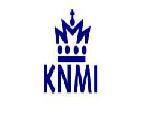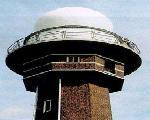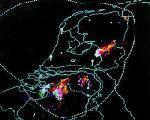In 2000 the Royal Dutch Meteorological Institute, KNMI, was confronted with expensive upgrades in its R&D; department. After a study and a pilot project, the organisation decided to switch to Linux on the desktop. This paper examines what was done three years ago and how the KNMI looks back on its experiences.

Introduction
The KNMI (Royal Netherlands Meteorological Institute) is an agency of the Dutch Ministry of Transport, Public Works and Watermanagement. It was founded in 1854 by Royal Decree. Professor C.H.D. Buys Ballot (1817-1890), the first director, chose the "Sonnenborgh" observatory in Utrecht for its location. In 1897 the KNMI moved to its present location in De Bilt.
Weather predictions and warnings for the general public, aviation and the maritime sector are done from the central weather room in De Bilt. Other locations are situated at four different airports and a marine airfield. The KNMI employs around 500 people.
The KNMI is active 24 hours a day. The combination of infrastructure, technology, science and service is unique in the area of weather, climate and seismology. Worldwide the KNMI closely cooperates with other institutes and research facilities. The institute participates in the European Centre for Medium-Range Weather Forecasts (ECMWF) in the U.K. And represents The Netherlands in numerous other international organisations, like the World Meteorological Organization (WMO), the Intergovernmental Panel on Climate Change (IPC) and the European meteorological satellite network Eumetsat.
Case
In 2000 the research and development (R&D) departments of the KNMI felt the need to upgrade their desktop workstations in order to be able to efficiently process the ever-increasing amount of data they had to deal with. Modern PC hardware had become both faster and cheaper than their traditional UNIX workstations, so they were convinced that PC hardware was the future for them. The scale of such a migration required the KNMI to initiate a European Tender procedure, but it was unclear what software platform they would move to.

When the need for upgrade came on the agenda, several people from the R&D departments suggested to migrate to Linux. This idea soon got support from the system administrators, who had always been agitated by forced upgrades and saw Linux as a way to avoid that in the future. Besides that they had always strongly felt that users play a central role in their tasks. \'They asked for it, we believed in it, so why not?\' But management was sceptic. In their view Linux was synonymous with chaos and not something they would base the continuity of their R&D on.
After some discussion all parties agreed that a migration to Linux would have to be evaluated thoroughly in order to make sure it was a solid choice. A pilot phase would have to show this was the case, while also making sure that the emotional aspects of everyone involved did not influence the outcome of the pilot.
The project
The system administrators created a full list of functionality that would have to be supported under Linux, ranging from support for their different laser printers to the most complex meteorological applications in use. In the weeks that followed all of this functionality was systematically verified in a test environment and checked off the list when it was proven to work.

After it was made sure that there was nothing that Linux couldn\'t support, management was convinced. Given the enthusiasm of the employees, they even started to get excited about this new platform they were acquiring.
The European Tender resulted in a choice for the hardware supplier. The Linux distribution of choice became RedHat 7.2 because of its focus on use in professional environments. KNMI system administrators started to configure a few of the systems with KDE desktops as they saw fit and placed them in a user test lab to see if their users could break the setup. After 3 weeks they had a list of items to adjust, but overall everything worked and the users were more than satisfied.
\'The migration that followed was a standard one,\' according to Hans Theihzen, system administrator of the KNMI. \'Migrations always have to be well thought-out, planned and executed. We did not consider Linux to be anything special in that sense.\'
The roll-out was done incrementally, starting with 10 workstations and repeatedly new users were migrated. Each iteration would generate some comments and things to be adjusted, but there were no big surprises.
During the roll-out, the KNMI invited their supplier to explain why the new system was better than the old one. After all the internal discussions on the subject had been held, users saw an external party, which confirmed the KNMI\'s choice to be the right one. Having an external party do this proved to be a way to gain some extra trust from the users and generated positive feedback.
Three years later
Today, three years after the start of the project, the KNMI runs Linux on approximately 120 of its R&D workstations and expects this number to continue to grow in the future. They are using the K Desktop Environment (KDE), OpenOffice and a number of commercial tools and suites on top of Linux. They still deploy a combination of RedHat 7.2/7.3, but are looking at slowly making a move towards RedHat 9 now.
For interoperability reasons with the Windows-world, employees use Citrix Metaframe on the desktop, allowing them to run Windows applications. Likewise, the Windows installations of the KNMI have received tools, such as Hummingbird\'s Exceed, to run Linux applications.
On the hardware side, the KNMI always buys standard and certified components, which makes procurement somewhat more expensive. They have found that using standard PC hardware in combination with Linux is much cheaper than what they were used to. Before the migration a single workstation would cost approximately €13,500 while now they can have one for about a third of that, around €4,500. They are happy with their current choice of supplier, but feel somewhat more free now in knowing that they can switch to another provider whenever such a need may arise.

They have downsized their software support from external parties to a bare minimum as they know that they can practically solve any issue themselves or with the help of the information found on the internet. Management is fine with this, as past experiences have proven this strategy to work.
Conclusion
Looking back, the users, the system administrators as well as management are happy with the decision to replace the old workstations with PCs running Linux. \'There were some challenges,\' said Theihzen, \'especially regarding interoperability with Windows applications, but it proved that 99% of all cases went smoothly. We solved the other 1% and in the end those solutions worked for us.\'
In retrospect the KNMI was one of the first organisations in The Netherlands to make the move to Linux on the desktop. Other parties with which the KNMI communicates seem to be doing the same.
\'What is important is that you do not rush into Linux out of enthusiasm. We planned everything thoroughly and avoid ad hoc decisions.\'
The KNMI system administrators have found Linux to be equally labour-intensive to manage as the old UNIX workstations. By applying more standardisation in the future, both in hardware and software, they hope to slim this down further.
References
KNMI homepage
http://www.knmi.nl
RedHat homepage
http://www.redhat.com
KDE homepage
http://www.kde.org
Paper version of this case study
Linux means good weather in IT-land (pdf 150 KB) [149 Kb]
© European Communities 2005
Reproduction is authorised provided the source is acknowledged.
The views expressed are not an official position of the European Commission.
Disclaimer

